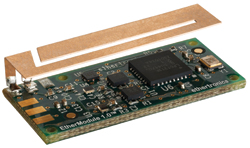
The machine-to-machine (M2M) market is continuing to grow exponentially. By 2021, annual global M2M revenue will hit $50.9 billion according to Analysys Mason. That’s also when M2M connections will have grown twentyfold to 2.1 billion worldwide, up from more than 100 million today. The growth will come from a wide range of products – from water meters and vending machines to point-of-sale (PoS) terminals, medical devices and many more. Vendors are excited about the growing revenue opportunities but these deployments do not come without challenges. In addition to a challenging RF environment, designers must figure out how to accommodate the wide range of frequencies used for M2M, given the limited amount of space within the device for the antenna and RF system componentry necessary for high performance and reliable connectivity. Additionally, vendors may not have RF expertise and test equipment in house to meet these challenges.
Ethertronics’ new EtherModule 1.0™, a turnkey, plug-and-play, active antenna system module combining Ethertronics’ advanced antenna architecture and EtherChip 1.0™ tunable capacitor using proprietary Air InteRFace Digital Conditioning™ technology on a printed circuit board, provides easy integration by wireless product designers. EtherModule 1.0 is a result of the collaboration of Ethertronics’ three divisions: antennas, systems and chips to provide the highest performance and connectivity under the most challenging RF conditions. Below are the reasons why EtherModule 1.0 is an excellent fit for M2M applications:
Active antenna system approach adapts to RF and environmental conditions. EtherModule 1.0 combines advanced antenna architecture, active components and proprietary algorithms to provide tuning capability. This design enables the antenna’s characteristics to be seamlessly adjusted to its dynamic requirements, such as hand, head and environmental effects, more bandwidth and frequency shift.
By dynamically sensing and optimizing the antenna system, EtherModule 1.0 gives M2M devices the unique ability to maintain optimal performance and connectivity even when the device is installed on a metal surface, such as a water meter housing, that would wreak havoc with a traditional passive antenna. The combination of an active design and closed-loop impedance matching also enables M2M vendors to create a single platform that can be quickly and cost-effectively integrated to meet the unique requirements of each new application. By comparison, passive designs typically require extensive and expensive customization.
Closed-loop impedance matching – this architecture enables the module to dynamically sense and optimize the antenna system, all without external control signals from the device. As a result, EtherModule can seamlessly adjust the antenna’s characteristics to meet its dynamic requirements, including frequency shift, hand, head and environmental effects or more bandwidth.
This technique automatically corrects frequency shifts that are a fact of life for nearly all M2M devices. For example, EtherModule 1.0 automatically corrects the detuning that occurs due to the user’s hand, such as in the case of a point-of-sale terminal, or to wet leaves and snow, such as in the case of a water meter in an underground vault.
EtherModule 1.0 also uses this technique to maximize bandwidth by automatically matching the antenna whenever the transceiver moves to a new frequency. This technique gets its name from the ability to conduct matching without any external information, such as which frequency is being used and/or the power level.
A highly compact footprint covers a wide frequency range. Another trend compounds the challenges for M2M devices: the growing number of bands that many applications require, such as two or more for LTE, another couple for 3G/2.5G fallback and possibly one for GPS. If the application requires a low frequency, such as 400 or 900 MHz, larger antennas are required. As a result, designers are further challenged to accommodate a wide range of frequencies, in a less than optimum amount of space, without undermining performance and reliability in the process.
EtherModule 1.0 enables developers to overcome both challenges. At just 35 × 15 × 10 mm, EtherModule 1.0 avoids the time and expense of a custom antenna solution. It covers a wide frequency range from 100 MHz to 3 GHz, so designers can create M2M devices that span 2G, 3G and 4G cellular, Bluetooth®, ISM, WiFi and ZigBee, depending on their needs. Additionally, a typical dynamic range of 20 dB ensures maximum performance across a wide range of frequencies and use cases.
Years of experience designing and integrating high performance antenna solutions.EtherModule 1.0 leverages Ethertronics’ 12-plus years of providing high-performance antenna solutions used by handset vendors to successfully pass operator certification. This experience benefits M2M vendors whose applications use cellular frequencies by significantly increasing the likelihood that an EtherModule 1.0 based M2M device will pass certification the first time, reducing development time and avoiding the expense of re-engineering.
EtherModule 1.0 benefits M2M vendors without the large RF engineering staffs that smartphone and tablet vendors have to re-design products that don’t pass operator certification the first time. And as a turnkey, plug-and-play solution, EtherModule 1.0 can be quickly and cost-effectively integrated into products. Lower development costs help vendors balance profitability with M2M’s price sensitivity, while rapid integration reduces both time-to-market and time-to-revenue.
The M2M opportunity is growing quickly, but it’s also getting more challenging. EtherModule 1.0 gives M2M device vendors an opportunity to overcome those challenges while quickly and cost-effectively creating products with market-differentiating features. It’s also the ideal foundation for applications that require high performance and mission-critical reliability.
Ethertronics,
San Diego, CA (858) 550-3820
usasales@ethertronics.com
www.ethertronics.com
